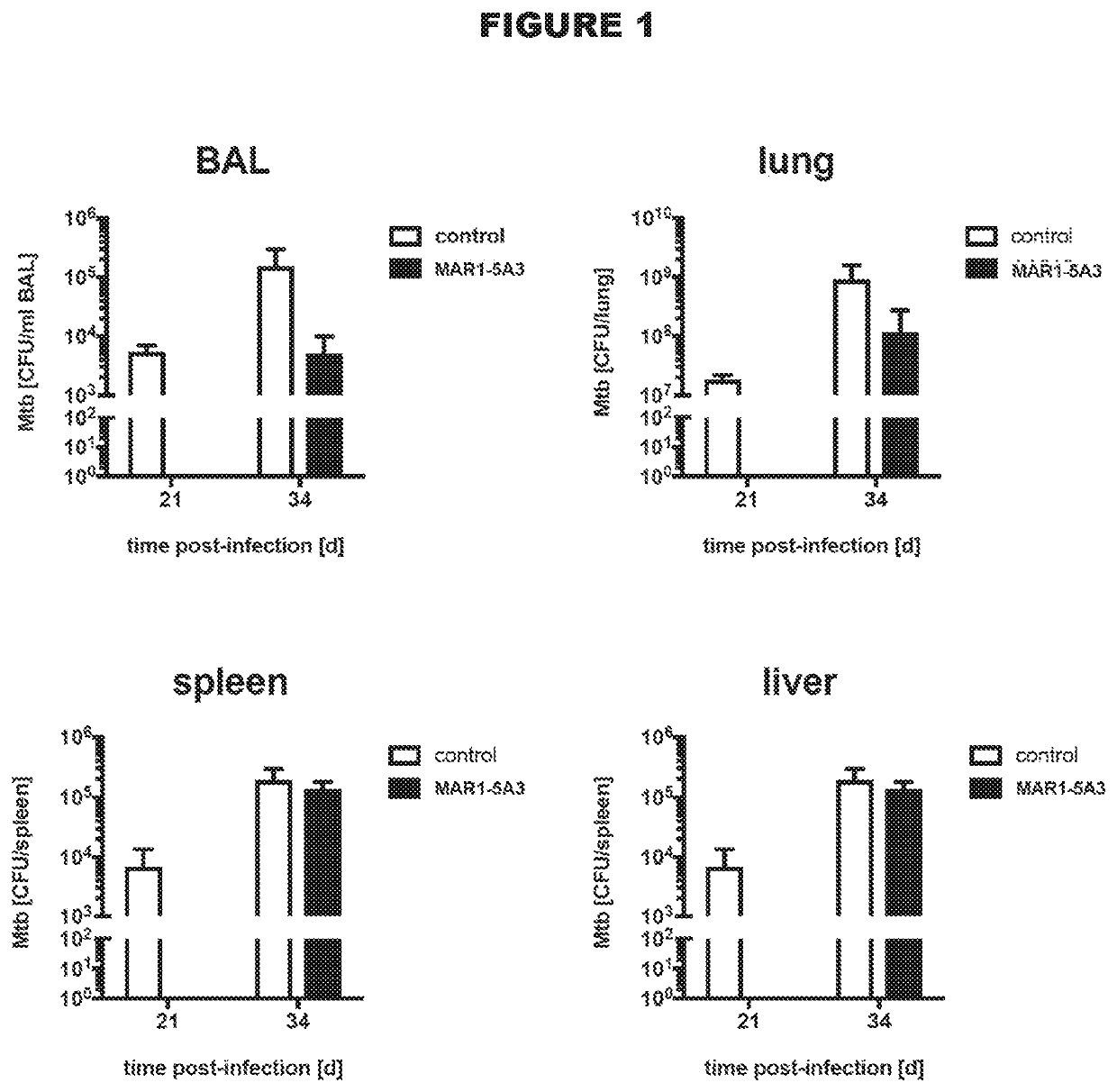Type 1 interferon receptor antagonists for use in methods of treating tuberculosis and other infectious diseases
a technology of interferon receptor and type 1 ifn, which is applied in the field can solve the problems of not being able to discover any new therapeutic approaches, the effect of not being universally observed, and the inability to induce the effect of type 1 ifn signalling
- Summary
- Abstract
- Description
- Claims
- Application Information
AI Technical Summary
Benefits of technology
Problems solved by technology
Method used
Image
Examples
example 1
[0117]Efficacy of Antibodies to IFNAR1 in a Mouse Model of Tuberculosis
[0118]A total of 40 mice (strain 129SvPas) were infected with M. tuberculosis strain H37Rv using a standard low-dose aerosol (LDA) infection with 100 colony forming units (CFUs). The infected mice were checked daily for clinical signs of disease and their body weight was monitored at least twice per week.
[0119]Three weeks after infection the mice in the treatment group were treated with an intraperitoneal injection of mouse anti-mouse IFNAR1 antibody (clone MAR1-5A3; Leeinco Technologies, Inc. USA), which was administered twice per week at a dose of 20 mg / kg for the remainder of the experiment. Mice in the control group were treated with PBS.
[0120]At 21 and 34 days post infection, 5 mice from each group were sacrificed and their lungs, liver, spleen and kidneys were collected. Serum was collected for analysis by terminal phlebotomy. Prior to isolation of the lungs, bronchoalveolar lavage (BAL) was performed with...
example 2
Efficacy of Antibodies to IFNAR1 in a Monkey Model of Tuberculosis
[0124]To determine the efficacy of therapy with an anti-type 1 interferon receptor antibody in treating tuberculosis in a model closer to humans, rhesus monkeys were used as a non-human primate model. The animals selected for the study were preferably of the same sex, between 4 to 8 years of age and had a body weight between 5 and 12 kg. The animals were subjected to a health check and were screened for antimycobacterial immunity, specific viruses, pathogenic ecto- and endoparasites and common bacteriological infections.
[0125]Two weeks before infection, blood and serum samples were collected and CT or PET / CT images of the lungs were taken to determine a pre-infection baseline for each animal. All animals received a low dose infectious challenge with M. tuberculosis strain Erdman K01. Animals were anesthetized with ketamine (10 mg / kg) followed by an injection of atropine (0.04 mg / kg). Lidocaine (0.1%) was sprayed onto...
PUM
| Property | Measurement | Unit |
|---|---|---|
| Time | aaaaa | aaaaa |
| Time | aaaaa | aaaaa |
| Time | aaaaa | aaaaa |
Abstract
Description
Claims
Application Information
 Login to View More
Login to View More - R&D
- Intellectual Property
- Life Sciences
- Materials
- Tech Scout
- Unparalleled Data Quality
- Higher Quality Content
- 60% Fewer Hallucinations
Browse by: Latest US Patents, China's latest patents, Technical Efficacy Thesaurus, Application Domain, Technology Topic, Popular Technical Reports.
© 2025 PatSnap. All rights reserved.Legal|Privacy policy|Modern Slavery Act Transparency Statement|Sitemap|About US| Contact US: help@patsnap.com


